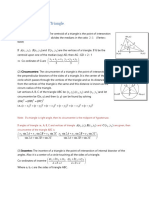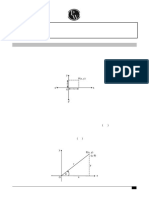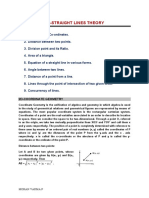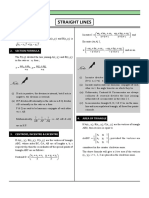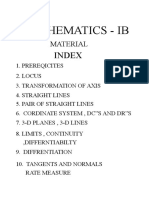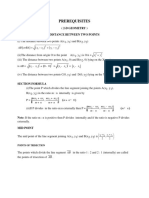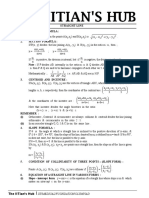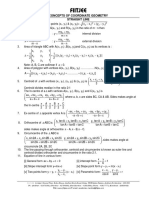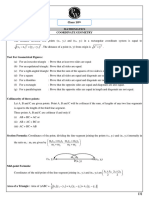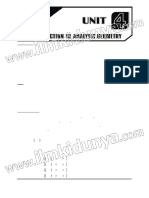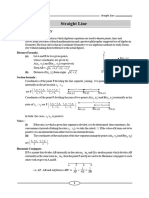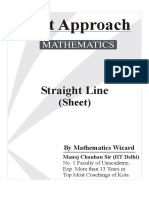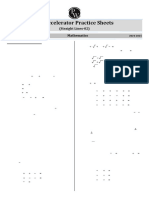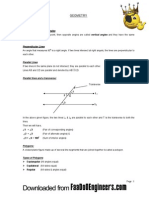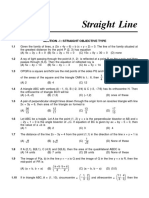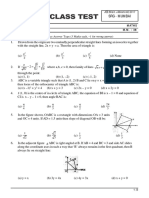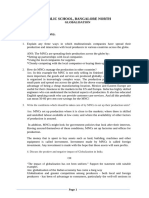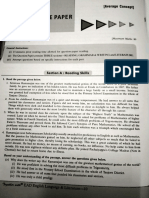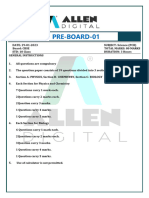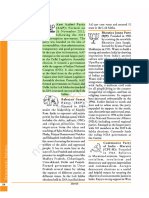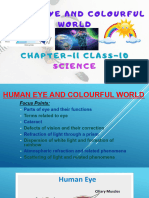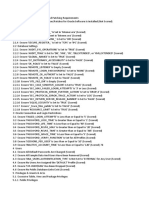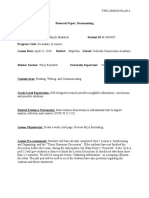Straight Lines & Circles-Mathematics
Straight Lines & Circles-Mathematics
Uploaded by
amogh biyalCopyright:
Available Formats
Straight Lines & Circles-Mathematics
Straight Lines & Circles-Mathematics
Uploaded by
amogh biyalCopyright
Available Formats
Share this document
Did you find this document useful?
Is this content inappropriate?
Copyright:
Available Formats
Straight Lines & Circles-Mathematics
Straight Lines & Circles-Mathematics
Uploaded by
amogh biyalCopyright:
Available Formats
STRAIGHT LINES
STRAIGHT LINES
1. Relation between cartesian co-ordinate & Polar co-ordinate system:
If (x,y) are cartesian co-ordinates of a point P, then : x = r cos , y= r sin and
-1 y
r= x 2 + y 2 , θ = tan
x
2. Distance formula and its Applications:
If A(x1,y1) and B(x2,y2) are two points, then A B = (x 2 -x 1 ) 2 + (y 2 -y 1 ) 2
Note :
(i) Three given points A,B and C are collinear, if sum of any two distances from AB,BC, CA is
equal to the remaining third else the points will be the vertices of a triangle.
(ii) Let A,B,C & D be the four given points in a plane. Then the
quadrilateral will be :
(a) Square if AB = BC = CD = DA & AC = BD ; AC BD
(b) Rhombus if AB = BC = CD = DA and AC BD; AC BD
(c) Parallelogram if AB = DC, BC = AD; AC BD;AC C BD
(d) Rectangle if AB = CD, BC = DA, AC = BD ; AC BD
3. Section Formula:
The co-ordinates of a point dividing a line joining the points A(x1,y1) and B(x2,y2) in the ratio
m:n is given by :
mx 2 nx1 my2 ny1
(a) For internal division : ,
mn mn
mx 2 nx1 my2 ny1
(b)For external division : ,
mn mn
(ax1 by 1 c)
(c) Line ax + by + c = 0 divides line joining points P(x1y1) & Q(x2y2) in ratio = – (ax by c)
2 2
x1 x2 y1 y 2
(d) Coordinates of mid point of AB are ,
2 2
4. Co-ordinates of some particular points :
Let A x1 ,y1 , B x2 ,y2 and C x3 ,y 3 are vertices of any triangle ABC, then
© 2022, BYJU’S. All rights reserved 1
STRAIGHT LINES
(a) Centroid :
(i) Centroid is the point of concurrence of the medians (line segment joining the mid point
of sides to opposite vertices).
(ii) Centroid divides the median in the ratio of 2 :1.
x1 x 2 x 3 y 1 y 2 y 3
(iii)Co-ordinates of centroid G ,
3 3
(iv) If P is any internal point of triangle such that area of APB, APC and BPC are same
then P must be centroid.
(b) Incenter :
Incenter is the point of concurrence of internal bisectors of the angles of a triangle. Also it
is a centre of the circle touching all the sides of a triangle
ax 1 bx 2 cx 3 ay1 by2 cy 3
Co-ordinates of incenter I ,
abc abc
where a, b, c are the sides of triangle ABC, opposite to A, B, C respectively.
Note:
(i) Angle bisector divides the opposite sides in the ratio of their corresponding sides. e.g.
BD A B c
DC A C b
(ii) Incenter divides the angle bisectors in the ratio b c : a, c a : b, a b : c
(c) Circumcenter :
It is the point of concurrence of perpendicular bisectors of the sides of a triangle. If O is
the circumcenter of any triangle ABC, then OA 2 OB2 OC 2 . Also it is a centre of a circle
touching all the vertices of a triangle.
© 2022, BYJU’S. All rights reserved
2
STRAIGHT LINES
(i) If a triangle is right angled, then its circumcenter is the mid point of hypotenuse.
(ii) Find perpendicular bisector of any two sides and solve them to find circumcentre.
(d) Orthocenter :
It is the point of concurrence of perpendiculars drawn from vertices to opposite sides of
a triangle and it can be obtained by solving the equation of any two altitudes.
A (x1 , y1)
D F
O
(x2 , y 2) (x3 , y 3)
B C
E
Note :
If a triangle is right angled triangle, then orthocenter is the point where right angle is
formed.
Remarks :
(i) If the triangle is equilateral, then centroid, incenter, orthocenter, circumcenter coincide.
(ii) Orthocenter, centroid and circumcenter are always collinear and centroid divides the
line joining orthocenter and circumcenter in the ratio 2 : 1 for non equilateral triangles.
(iii) In an isosceles triangle centroid, orthocenter, incenter & circumcenter lie on the same
line.
(e) Ex-centers :
Point of concurrence of two external angle bisectors and one internal angle bisector of a
triangle is called Ex-center.
The center of a circle which touches side BC and the extended portions of sides AB and AC
is called the ex-center of ABC with respect to the vertex A. It is denoted by I1 and its
coordinates are
ax 1 bx 2 cx 3 ay 1 by 2 cy 3
I1 ,
a b c a b c
© 2022, BYJU’S. All rights reserved 3
STRAIGHT LINES
Similarly ex-centers of ABC with respect to vertices B and C are denoted by I2 and I3
respectively , and
ax - bx 2 + cx 3 ay 1 - by 2 + cy 3 ax 1 + bx 2 - cx 3 ay 1 + by 2 - cy 3
I2 1 , , I3 ,
a -b + c a - b + c a+b - c a+b-c
5. Area of triangle :
Let A(x1,y1), B(x2,y2) and C(x3,y3) are vertices of a triangle, then
x1 y1 1
1 1
Area of ABC = x2 y2 1 = |[x1(y2 – y3) + x2(y3 – y1) + x3(y1 – y2)]|
2 2
x3 y3 1
To remember the above formula, take the help of the following method:
1 x1 x2 x3 x1 1
= = | [(x1y2– x2y1) + (x2y3–x3y2)+(x3y1–x1y3)] |
2 y1 y2 y3 y1 2
Remarks :
(i) If the area of triangle joining three points is zero, then the points are collinear.
(ii) Area of Equilateral triangle : If altitude of any equilateral triangle is
P2 a2 3
P, then its area = . If 'a' be the side of equilateral triangle, then its areaa =
3 4
(iii) Area of quadrilateral whose consecutive vertices are :
1 x1 - x3 y1 - y3
(x1, y1), (x2, y2), (x3, y3) & (x4, y4) is
2 x2 - x4 y2 - y4
6. Conditions of collinearity For three points :
Three points (x1, y1), (x2, y2), and (x3, y3) are collinear if any one of the given point lies on the
line passing through the remaining two points Thus the required condition is-
x1 y1 1
y3 - y1 x 3 - x1 x1 - x2 y1 - y2
= or = or x 2 y2 1
y2 - y1 x2 - x1 x1 - x3 y1 - y3 =0
x3 y3 1
© 2022, BYJU’S. All rights reserved
4
STRAIGHT LINES
7. Equation of straight Line :
A relation between x and y which is satisfied by co-ordinates of every point lying on a line
is called equation of the straight line. Here, every linear equation in variable x and y always
represents a straight line i.e. ax + by + c = 0 ; a & b 0 simultaneously..
(a) Equation of a line parallel to x-axis at a distance 'a' from x-axis is y = a or y = – a
(b) Equation of x-axis is y = 0
(c) Equation of a line parallel to y-axis at a distance 'b' from y -axis is x = b or x = – b
(d) Equation of y-axis is x = 0
8. Slope of line :
If a given line makes an angle (0° < 180°, 90°) with the positive direction of x-axis,
then slope of this line will be tan and is usually denoted by the letter m i.e. m = tan.
Obviously the slope of the x-axis and line parallel to it is zero and y-axis and line parallel to
it does not exist.
y2 y1
If A(x1,y1) and B(x2, y2) & x1 x2 then slope of line AB = x x
2 1
9. Standard forms of a straight line :
(a) Slope Intercept form : Let m be the slope of a line and c its intercept on y-axis. Then the
equation of this straight line is written as : y = mx + c
(b) Point Slope form : If m be the slope of a line and it passes through a point (x1,y1), then its
equation is written as : y – y1 = m(x – x1)
(c) Two point form : Equation of a line passing through two points (x1,y1) and (x2,y2) is
written as :
x y 1
y2 – y1 x y1 1 0
y – y1 (x – x 1 ) or 1
x2 – x1 x2 y2 1
© 2022, BYJU’S. All rights reserved 5
STRAIGHT LINES
(d) Intercept form : If a and b are the intercepts made by a line on the axes of x and y
x y
respectively, then its equation is written as : + =1
a b
(e) Normal form : If p is the length of perpendicular on a line from the origin, and the
angle which this perpendicular makes with positive direction of x-axis, then the equation
of this line is written as : xcos + ysin = p (p is always positive) where 0 < 2.
(f) Parametric form : The equation of a straight line which
passes through a point A(h, k) and makes an angle with the positive direction of the x-
xh yk
axis is =r
co s sin
Any point P on the line will be of the form (h + r cos, k + r sin), where |r| gives the
distance of the point P from the fixed point (h, k).
y P L
r (x, y)
A
(h, k)
L'
x
O
(g) General form : We know that a first degree equation in x and y,
ax +by + c = 0 always represents a straight line. This form is known as general form of
straight line.
-a coeff. of x
(i) Slope of this line = b = - coeff. of y
c c
(ii)Intercept by this line on x-axis = – and intercept by this line on y-axis = –
a b
(iii) To change the general form of a line to normal form, first take c to right hand side and
make it positive, then divide the whole equation by a2 b 2 .
10. Angle between two lines :
(a) If be the angle between two lines : y =m 1x + c 1 and y = m 2 x +c 2, then
m1 - m2
ta n θ = ±
1 + m 1m 2
© 2022, BYJU’S. All rights reserved
6
STRAIGHT LINES
(b) If equation of lines are a1x+b1y+c1=0 and a2x+b2y+c2=0, then these line are -
a1 b 1 c
(i) Parallel 1
a2 b 2 c2
(ii) Perpendicular a1a2+b1b2=0
a1 b 1 c 1
(iii) Coincident = =
a2 b 2 c 2
a b
(iii) Intersecting
1
1
a 2 b 2
11. Length of perpendicular from a point on a line :
ax 1 + by 1 + c
Length of perpendicular from a point (x1,y1) on the line ax + by + c = 0 is
a2 + b 2
In particular, the length of the perpendicular from the origin on the line ax + by + c = 0
|c|
is P =
a2 + b 2
12. Distance between two parallel lines :
(a) The distance between two parallel lines ax + by + c 1= 0 and ax + by + c2= 0 is
c1 c2
a2 b 2
(Note : The coefficients of x & y in both equations should be same)
p1 p2
(b) The area of the parallelogram = , where p1 & p2 are distances between two pairss
s in
of opposite sides & is the angle between any two adjacent sides . Note that area of the
parallelogram bounded by the lines y = m1x + c1 , y = m1x + c2 and y = m2x + d1 , y = m2x
(c 1 c 2 ) (d 1 d 2 )
+ d2 is given by m1 m2
13. Equation of lines parallel and perpendicular to a given line:
(a) Equation of line parallel to line ax + by + c = 0
ax + by + = 0
(b) Equation of line perpendicular to line ax + by + c = 0
bx – ay + k = 0
Here , k, are parameters and their values are obtained with the help of additional
information given in the problem.
© 2022, BYJU’S. All rights reserved 7
STRAIGHT LINES
14. Straight line making a given angle with a line :
Equations of lines passing through a point (x1,y1) and making an angle , with the line y=
mx+c is written as :
m ta n
y y1 (x x 1 )
1 m ta n
15. Position of two points with respect to a given line :
Let the given line be ax + by + c = 0 and P(x1, y1), Q(x2, y2) be two points. If the quantities ax1
+ by1 + c and ax2 + by2 + c have the same signs, then both the points P and Q lie on the same
side of the line ax + by + c = 0. If the quantities ax1 + by1 + c and ax2 + by2 + c have opposite
signs, then they lie on the opposite sides of the line.
16. Concurrency of lines :
(a) Three lines a1x + b1y + c1 = 0; a2x + b2y + c2 = 0 and a3x + b3y + c3 = 0 are concurrent, if
a1 b1 c1
a2 b2 c2 0
=
a3 b3 c3
Note :
If lines are concurrent then = 0 but if = 0 then lines may or may not be concurrent
{lines may be parallel}
17. Reflection of a point :
Let P(x, y) be any point, then its image
with respect to
(a) x-axis is Q(x, –y)
(b) y-axis is R(–x, y)
(c) origin is S(–x,–y)
(d) line y = x is T(y, x)
18. Transformation of axes:
(a) Shifting of origin without rotation of axes :
If coordinates of any point P (x, y) with respect to new origin ()will
be (x'y') then x = x' + , y = y' +
or x' = x – , y' = y –
Thus if origin is shifted to point () without rotation of axes, then new equation of curve
© 2022, BYJU’S. All rights reserved
8
STRAIGHT LINES
can be obtained by substituting x + in place of x and y + in place of y.
Y
Y'
P(x,y)
(x',y')
y'
y
X'
O' x'
X
O x
(b) Rotation of axes without shifting the origin :
Let O be the origin. Let P (x, y) with respect to axes OX and OY and let P (x', y') with
respect to axes OX' and OY' where X'OX = YOY' = ,
then x = x' cos – y' sin
y = x' sin + y' cos
and x' = x cos + y sin
y' = –x sin + y cos
The above relation between (x, y) and (x', y') can be easily obtained with the help of following
table
Old
New x y
x' cos sin
y' –sin cos
19. Equation of Bisectors of angles between two lines :
If lines a1x+b1y+c1=0 and a2x + b2y+c2=0 are intersecting, then equation of angle bisectors
between these lines are :
a1 x b 1 y c 1 a2 x b 2 y c 2
..........(1)
a b
2
1
2
1 a22 b 22
(a) Equation of angle bisector containing origin :
If the equation of the lines are written with constant terms c1 and c2 positive, then the
equation of the angle bisectors containing the origin is obtained by taking positive sign in
(1)
© 2022, BYJU’S. All rights reserved 9
STRAIGHT LINES
(b) Equation of bisector of acute/obtuse angles :
See whether the constant terms c1 and c2 in the two equation are +ve or not. If not then
multiply both sides of given equation by-1 to make the constant terms positive.
Determine the sign of a1a2 + b1b2
If sign of a1a2+b1b2 For obtuse angle bisector For acute angle bisector
+ use + sign in eq. (1) use – sign in eq. (1)
– use – sign in eq. (1) use + sign in eq. (1)
i.e. if a1a2 + b1b2 > 0, then the bisector corresponding to + sign gives obtuse angle bisector
a1 x b1 y c1 a2 x b 2 y c 2
a b
2
1
2
1 a22 b 22
20. Family of lines :
If equation of two lines be P a1x + b1y + c1= 0 and Q a2x + b2y + c2=0, then the equation
of the lines passing through the point of intersection of these lines is : P + Q = 0 or a1x +
b1y + c1 + (a2x + b2y + c2) = 0. The value of is obtained with the help of the additional
informations given in the problem.
21. General Equation and Homogeneous Equation of Second Degree :
(a) The general equation of second degree
ax2 + 2hxy + by2 + 2gx + 2fy + c = 0 represents a pair of straight lines,
a h g
if =abc+2fgh – af – bg – ch = 0 or
2 2 2 h b f 0 , h2 ab, g2 ca and f2 bc
g f c
2 h2 ab
(b) If be the angle between the lines, then tan
ab
Obviously these lines are
(i) Parallel, if = 0, h2 = ab or if h2 = ab and bg2 = af2
(ii) Perpendicular, if a + b =0 i.e. coeff. of x2 + coeff. of y2 = 0.
(c) Homogeneous equation of 2nd degree ax2 + 2hxy + by2 = 0 always represent a pair of
straight lines whose equations are
h h2 ab
y= b
x y=mx&y=mx
1 2
2h a
and m1 + m2 = – : m1m2 =
b b
These straight lines pass through the origin and to find the angle between these lines
same formula as given for general equation is used.
The condition that these lines are:
(i) At right angle to each other is a + b = 0. i.e. co-efficient of x2 + co-efficient of y2 = 0.
(ii) Coincident if h2 = ab.
© 2022, BYJU’S. All rights reserved
10
STRAIGHT LINES
(iii) Equally inclined to the axis of x if h = 0. i.e. coeff. of xy = 0.
(d) The combined equation of angle bisectors between the lines represented by
x 2 - y 2 xy
homogeneous equation of 2nd degree is given by , a b, h 0.
a-b h
(e) Pair of straight lines perpendicular to the lines ax2 + 2hxy + by2 = 0
and through origin are given by bx2–2hxy + ay2 = 0.
(f) If lines ax2 + 2hxy + by2 + 2gx + 2fy+c=0 are parallel then distance between them is =
g 2 ac (f 2 – bc)
2 or 2 b(a b)
a(a b)
22. Equations of lines joining the points of intersection of a line and a
curve to the origin :
(a) Let the equation of curve be :
ax2 + 2hxy + by2 + 2gx + 2fy + c = 0 ...(i)
and straight line be
lx + my + n = 0 ...(ii)
Now joint equation of line OP and OQ joining the origin and points of intersection P and Q
can be obtained by making the equation
(i) homogenous with the help of equation of the line. Thus required equation is given by-
x my
2
ax +2hxy+by +2(gx+fy) x my + c
2 2
0
n n
23. Standard Results:
2c 2
(a) Area of rhombus formed by lines a |x|– b | y | + c = 0 or ax by + c = 0 is
| ab |
c2
(b) Area of triangle formed by line ax + by + c = 0 and axes is .
2 | ab |
(c) Co-ordinate of foot of perpendicular (h,k) from (x1,y1) to the line ax + by + c = 0 is
h x1 k y1 (ax 1 by1 c)
given by
a b a 2 b2
(d) Image of point (x1, y1) w.r.t the line ax + by + c = 0 is given by
h - x1 k - y1 -2(ax 1 + by 1 + c)
= =
a b a 2 + b2
© 2022, BYJU’S. All rights reserved 11
CIRCLES
CIRCLES
1. Definition :
A circle is the locus of a point which moves in a plane in such a way that its distance from
a fixed point remains constant. The fixed point is called the centre of the circle and the
constant distance is called the radius of the circle.
2. Standard Equations of the Circle :
(a) Central Form :
If (h, k) is the centre and r is the radius of the circle then its equation is (x–h)2 + (y – k)2 =
r2
(b) General equation of circle: x2 + y2 + 2gx + 2fy + c = 0. where g,f,c are constants then
centre is (–g,–f)
coefficient of x coefficient of y
i.e. , and radius r g f c
2 2
2 2
Note :
The general quadratic equation in x and y.
ax2 + by2 + 2hxy + 2gx + 2fy + c = 0 represents a circle if :
(i) coefficient of x2 = coefficient of y2 or a = b 0
(ii) coefficient of xy = 0 or h = 0
(iii) (g2 + f2 – c) 0 (for a real circle)
(c) Intercepts cut by the circle on axes :
The intercepts cut by the circle x2 + y2 + 2gx + 2fy + c =0 on :
(i) x-axis = 2 g 2 – c (ii) y-axis 2 f 2 – c
Note :
Intercept cut by a line on the circle x2 + y2 + 2gx + 2fy+c = 0 or length of chord of the circle
2 a 2 - P 2 where 'a' is the radius and 'P' is the length of perpendicular from the centre to
o
the chord.
(d) Diameter form of circle :
If A(x1,y1) and B(x2,y2) are the end points of the diameter of the circle then the equation of
the circle is given by (x–x1) (x–x2)+(y–y1)(y–y2) = 0
© 2022, BYJU’S. All rights reserved 1
CIRCLES
P(x,y)
O.
(x1 ,y1) A B(x2,y2)
C
(e) The parametric forms of the circle :
(i) The parametric equation of the circle x2+y2 = r2 are x = r cos, y = r sin ; [0, 2)
(ii) The parametric equation of the circle (x – h)2 + (y – k)2 = r2 are
x = h + r cos, y = k + r sin where is parameter.
(iii) The parametric equation of the circle x2 + y2 + 2gx + 2fy + c = 0 are x = – g + g 2 + f 2 – c cos,
y = –f + g 2 + f 2 – c sin where is parameter..
Note that equation of a straight line joining two point & on the circle x2 + y2 = a2 is
x cos + y sin = a cos
os
2 2 2
3. Position of a point w.r.t circle: :
(a) Let the circle be x2 + y2 + 2gx + 2fy + c = 0
and the point be (x1,y1) then-
Point (x1,y1) lies out side the circle or on the circle or inside the circle according as
x12 + y12 + 2gx1 +2fy1 + c >, =, < 0 or S1 >, =, < 0
(b) The greatest & the least distance of a point A from a circle with centre C & radius r is
AC + r & AC – r respectively.
(c) If a line drawn from a point p(x1,y1) intersects the circle S = 0 in two distinct points A and
B then PA.PB = S1 and PA.PB = CP2–r2 is called the power of the point P w.r.t. circle S = 0
B
A r S x2 + y2 + 2gx + 2fy + c = 0
C S1 = x12 + y12 + 2gx1 + 2fy1 + c
P
4. Tangent Line of Circle :
When a straight line meet a circle on two coincident points then it is called the tangent of
the circle.
© 2022, BYJU’S. All rights reserved
2
CIRCLES
(a) Condition of Tangency :
The line L = 0 touches the circle S = 0 if P the length of the perpendicular from the centre
to that line and radius of the circle r are equal i.e. P = r.
(b) Equation of the tangent (T = 0) :
(i) Tangent at the point (x1,y1) on the circle x2+ y2 = a2 is xx1 + yy1 = a2.
(ii) (1) The tangent at the point (acos t, asin t) on the circle x2 + y2 = a2 is xcos t + ysin t = a
(2) The point of intersection of the tangents at the points
acos
2 asin
2
P () and Q () is , .
cos 2 cos
2
(iii) The equation of tangent at the point (x1,y1) on the circle
x2 + y2 + 2gx + 2fy + c = 0 is T = 0
xx1 + yy1 + g(x + x1) + f(y + y1) + c = 0
(iv) If line y = mx + c is a straight line touching the circle
x2 + y2 = a2, then c = ± a 1 m2 and contact points are
e
am a a2m a2
, or , and equation of tangent is
1 + m2 1 + m2 c c
y = mx ± a 1 + m 2
(v) The equation of tangent with slope m of the circle
(x – h)2 + (y – k)2 = a2 is
(y – k) = m(x – h) ± a 1 + m 2
Note :
To get the equation of tangent at the point (x1 y1) on any curve we replace x2 with xx1, y2
x x1 y y1 xy yx 1
with yy1, x with , y with , xy with 1 and c in place of c.
2 2 2
(c) Length of tangent ( S 1 ) :
The length of tangent drawn from point
(x1,y1) out side the circle
© 2022, BYJU’S. All rights reserved 3
CIRCLES
S x2 + y2 + 2gx + 2fy + c = 0 is,
PT= S1 = x 12 y 12 2gx 1 2fy 1 c
T
P(x1 ,y1 )
(d) Equation of Pair of tangents (SS1 = T2) :
Let the equation of circle S x2 + y2 = a2 and P(x1,y1) is any point outside the circle. From the
point we can draw two real and distinct tangent PQ & PR and combine equation of pair of
tangents is -
(x2 + y2 – a2) (x12 + y12 – a2) = (xx1 + yy1 – a2)2 or SS1 = T2
5. Normal of circle :
Normal at a point of the circle is the straight line which is perpendicular to the tangent at
the point of contact and passes through the centre of circle.
(a) Equation of normal NT at point T(x1,y1) of circle x2 + y2 + 2gx + 2fy
+ c = 0 is
y +f
y– y1 = 1 (x - x 1 )
x1 + g
y y1
(b) The equation of normal on any point (x1,y1) of circle x2 + y2 = a2 is
x x1
6. Chord of Contact:
If two tangents PT1 & PT2 are drawn from the point P (x1, y1) to the circle
S x2 + y2 + 2gx + 2fy + c = 0 ,
then the equation of the chord of contact T1T2 is :
xx1 + yy1 + g (x + x1) + f (y + y1) + c = 0 (i.e. T = 0).
© 2022, BYJU’S. All rights reserved
4
CIRCLES
7. Equation Of The Chord With A Given Middle Point (T = S1) :
The equation of the chord of the circle S x2 + y2 + 2gx + 2fy + c = 0 in terms of its mid
x1 g
point M (x1 , y1) is y - y1 = - (x - x1).
y1 f
This on simplification can be put in the form xx1 + yy1 + g (x + x1) + f (y + y1) + c = x12 +
y12 + 2gx1 + 2fy1 + c which is designated by T = S1.
8. Director Circle :
The locus of point of intersection of two perpendicular tangents to a circle is called director
circle. Let the circle x2 + y2 = a2. Then the equation of the director circle is x2 + y2 = 2a2.
director circle is a concentric circle whose radius is 2 times the radius of the circle.
Note :
The director circle of
x2 + y2 + 2gx + 2fy + c = 0 is
x2 + y2 + 2gx + 2fy + 2c– g2 – f2 = 0
9. Pole and Polar :
Let any straight line through the given point A(x1,y1) intersect the given circle S =0 in two
points P and Q and if the tangent of the circle at P and Q meet at the point R then locus of
point R is called polar of the point A and point A is called the pole, with respect to the
given circle.
The equation of the polar is the T=0, so the polar of point (x1,y1) w.r.t circle x2 + y2 + 2gx + 2fy
+ c = 0 is xx1+ yy1+ g(x + x1) + f(y + y1)+c = 0
Pole of a given line with respect to a circle
To find the pole of a line we assume the coordinates of the pole then from these coordinates
we find the polar. This polar and given line represent the same line. Then by comparing
the coefficients of similar terms we can get the coordinates of the pole. The pole of lx +
a2 ma2
my + n =0 w.r.t. circle x + y = a will be n , n
2 2 2
10. Family Of Circles :
(a) The equation of the family of circles passing through the points of intersection
of two circles S1 = 0 & S2 = 0 is : S1 + K S2 = 0 (K –1).
(b) The equation of the family of circles passing through the point of Intersection
of a circle S = 0 & a line L = 0 is given by S+ KL = 0.
(c) The equation of a family of circles passing through two given points (x1 , y1) & (x2 , y2)
can be written in the form :
© 2022, BYJU’S. All rights reserved 5
CIRCLES
x y 1
(x - x1) (x - x2) + (y - y1) (y - y2) + K x 1 y 1 1 = 0 where K is a parameter..
x2 y2 1
(d) The equation of a family of circles touching a fixed line y - y1 = m (x - x1) at the fixed
point (x1 , y1) is (x - x1)2 + (y - y1)2 + K [y - y1 - m (x - x1)] = 0, where K is a parameter.
(e) Family of circles circumscribing a triangle whose sides are given by L1 = 0 ; L2 = 0 &
L3 = 0 is given by ; L1L2 + L2L3 + L3L1 = 0 provided coefficient of xy = 0 & coefficient of x2
= coefficient of y2.
(f) Equation of circle circumscribing a quadrilateral whose sides in order are represented
by the lines L1 = 0, L2 = 0, L3 = 0 & L4 = 0 is L1L3 + L2L4 = 0 provided coefficient of x2 =
coefficient of y2 and coefficient of xy = 0.
11. Direct and Transverse common tangents :
Let two circles having centre C1, C2, radii r1, r2 and C1C2 is the distance between their centres
then :
(a) Circles touch each other:
(i) Externally if C1C2 = r1 + r2 point P divides C1C2 in the ratio r1 : r2 (internally).
In this case there are three common tangents.
(ii) Internally if C1C2 = |r1–r2| point P divides C1C2 in the ratio r1 : r2 externally and in this case
there will be only one common tangent.
(b) The circles will intersect : when |r1 – r2| < C1C2 < r1 + r2 in this case there are two
common tangents.
(c) The circles will not intersect :
(i) One circle will lie inside the other circle if C1C2 <
|r1–r2| In this case there will be no common tangent.
© 2022, BYJU’S. All rights reserved
6
CIRCLES
(ii) Circles neither touch nor intersect then C1C2> r1+r2 and in this
case there will be four common tangents.
Lines PQ and RS are called transverse or indirect or internal common tangents and these
lines intersect line C1C2 at T1and T1 divides the line C1C2 in the ratio r1 : r2 internally and
lines AB & CD are called direct or external common tangents. These lines intersect C1C2
produced at T2. Thus T2 divides C1C2 externally in the ratio r1 : r2.
Note : Length of direct common tangent = (C 1 C 2 )2 (r1 r2 )2
Length of transverse common tangent = (C 1 C 2 )2 (r1 r2 )2
12. The angle of intersection of two circles :
Definition : The angle between the tangents of two circles at the point of intersection of
the two circles is called angle of intersection of two circles.
2g1g2 2f1f2 c1 c2 r12 r22 d2
then cos or cos
2 g12 f12 c1 g22 f22 c2 2r1r2
Here r1 and r2 are the radii of the circles and d is the distance between their centres.
If the angle of intersection of the two circles is a right angle then such circles are called
"Orthogonal circles" and condition for the circles to be orthogonal is -
2g1g2 + 2f1f2 = c1+ c2 or r12 + r22 = d2
13. Radical axis of the two circles (S1 – S2= 0) :
Definition : The locus of a point, which moves in such a way that the length of tangents
drawn from it to the circles are equal is called the radical axis. If two circles are -
© 2022, BYJU’S. All rights reserved 7
CIRCLES
S1 x2 + y2 + 2g1x + 2f1 y + c1 =0
S2 x2 + y2 + 2g2x + 2f2y + c2 = 0
Then the equation of radical axix is given by S1– S2= 0
Note :
(i) If two circles touches each other then common tangent radical axis
S1-S2=0 S1-S2=0
(ii) If two circles intersect each other then common chord is radical axis
S1-S2=0
(iii) If two circles cuts third circle orthogonally then radical axis of first two is locus of
centre of third circle.
(iv) The radical axis of the two circles is perpendicular to the line joining the centres of two
circles but not always pass through mid point of it.
14. Radical centre :
The point of concurrence of radical axes of three circles whose centres are non collinear,
taken in pairs is called their radical centre.
Note :
(i) The circle with centre as radical centre and radius equal to the length of tangent from
radical cent any of the circle, will cut the three circles orthogonally.
C
I
C1 T1
=
C2
=
T2 =
III
T3 II B
A
C3
(ii) If three circles are drawn on three sides of a triangle taking them as diameter then its
orthocenter will be its radical centre.
(iii) The radical centre of three circles is the point from which length of tangents on three
circles are equal.
© 2022, BYJU’S. All rights reserved
8
You might also like
- 07 Straight Line - Sheet - by MC SirDocument44 pages07 Straight Line - Sheet - by MC SirPiyush Agarwal100% (1)
- Straight LinesDocument15 pagesStraight Linescatchshawty1614No ratings yet
- Coordinate Some Points of A TriangleDocument2 pagesCoordinate Some Points of A TrianglecatchaNo ratings yet
- CH 8. Straight Line (Math +1)Document46 pagesCH 8. Straight Line (Math +1)Dinesh BabuNo ratings yet
- Coordinate Geometry: For IOQM BoosterDocument30 pagesCoordinate Geometry: For IOQM Boosteraryaanstudys777No ratings yet
- Straght Lines TheoryDocument24 pagesStraght Lines TheorySk 3jNo ratings yet
- Distance, Section, Area, Locus FOR PUBLISHINGDocument12 pagesDistance, Section, Area, Locus FOR PUBLISHINGkhv_19No ratings yet
- Straight Line (TN)Document20 pagesStraight Line (TN)Raju SinghNo ratings yet
- Coordinate System For 2D Level 1 and 2Document19 pagesCoordinate System For 2D Level 1 and 2BulusuMurtyNo ratings yet
- Coordinate Geometry PDFDocument11 pagesCoordinate Geometry PDFManoj SharmaNo ratings yet
- Chapter 10 - Straight Lines Revision NotesDocument6 pagesChapter 10 - Straight Lines Revision NotesRounak BasuNo ratings yet
- Chapter 10 - Straight Lines Revision NotesDocument6 pagesChapter 10 - Straight Lines Revision NotesShanaz ParsanNo ratings yet
- Straight Lines-01 - TheoryDocument31 pagesStraight Lines-01 - TheoryRaju SinghNo ratings yet
- Coordinate Geometry NotesDocument11 pagesCoordinate Geometry NotesThe Unwanted RogueNo ratings yet
- StraightLines FinalSendDocument14 pagesStraightLines FinalSendAaryan Keshan100% (1)
- Maths IBDocument376 pagesMaths IBAddalla veerrajuNo ratings yet
- Co-Ordinate Geometry: Y I II Quadrant Quadrant (-.,+) (+,+) 1 2 3Document11 pagesCo-Ordinate Geometry: Y I II Quadrant Quadrant (-.,+) (+,+) 1 2 3Aarti Sharma100% (1)
- IB 01 Coordinate System (1 5)Document5 pagesIB 01 Coordinate System (1 5)eamcetmaterials86% (7)
- Caps 22Document4 pagesCaps 22Sai Venkata Krishna GNo ratings yet
- Unit 15 STRAIGHT LINES AND PAIR OF LINES-1Document34 pagesUnit 15 STRAIGHT LINES AND PAIR OF LINES-1RonnyNo ratings yet
- 2D Part 01 C of PointsDocument11 pages2D Part 01 C of PointsVIBHANSHU SINGHNo ratings yet
- PREREQUISITES 2d THEORYDocument12 pagesPREREQUISITES 2d THEORYnarendravarmacpenmatsaNo ratings yet
- Key Concept (Straight Line, Circle, Parabola, Ellipse, Hyperbola)Document21 pagesKey Concept (Straight Line, Circle, Parabola, Ellipse, Hyperbola)Ayah100% (1)
- Formula Sheet of Coordinate GeometryDocument14 pagesFormula Sheet of Coordinate GeometryBhavesh Kumar100% (1)
- 02-03-2020 Point & Straight Line JDocument21 pages02-03-2020 Point & Straight Line Janiket969354No ratings yet
- Coordinate Geometry - Short NotesDocument2 pagesCoordinate Geometry - Short NotesgaustricnelsonNo ratings yet
- 0 01 PREREQUISITES 2d THEORY PDFDocument12 pages0 01 PREREQUISITES 2d THEORY PDFSai ReddyNo ratings yet
- 2D - Straight Lines & Circles (Day - 01 (15-03-24)Document14 pages2D - Straight Lines & Circles (Day - 01 (15-03-24)PuruvamitraNo ratings yet
- Worksheet 77StraightLineivDocument8 pagesWorksheet 77StraightLineivAtharva SinghNo ratings yet
- @bohring Bot × @JEE Tests 2D STRAIGHT LINES & CIRCLES DAY 01 15Document14 pages@bohring Bot × @JEE Tests 2D STRAIGHT LINES & CIRCLES DAY 01 15Idhant SinghNo ratings yet
- Mathematics Formula: Topic Phase-1Document7 pagesMathematics Formula: Topic Phase-1testerNo ratings yet
- Topic: Straight LinesDocument13 pagesTopic: Straight LinesAmit GNo ratings yet
- Best Approach Straight Lines Answer KeyDocument82 pagesBest Approach Straight Lines Answer Keynamangoyal1024No ratings yet
- Complete Maths JeeDocument445 pagesComplete Maths JeeEkant Yadav100% (1)
- Coordinate GeometryDocument27 pagesCoordinate GeometryVenkat GowdaNo ratings yet
- 07 Straight Line BrahmastraDocument16 pages07 Straight Line BrahmastraAnkit Ranjan100% (1)
- WT 7 (Circle)Document2 pagesWT 7 (Circle)Sipra PaulNo ratings yet
- 4.1, 4.2.Document28 pages4.1, 4.2.tanjiroanime4291No ratings yet
- Key Concepts & Practice Questions - 2Document6 pagesKey Concepts & Practice Questions - 2Saroja PurohitNo ratings yet
- Straight Line Theory (1-27) - F24Document27 pagesStraight Line Theory (1-27) - F24neerajNo ratings yet
- Sheet - 01 - Straight LinesDocument15 pagesSheet - 01 - Straight LinesNoob Game PlayNo ratings yet
- Straight+Line Quick+Revision+in+one+shotDocument42 pagesStraight+Line Quick+Revision+in+one+shotCristiano RonaldoNo ratings yet
- StraightLine Sheet3Document79 pagesStraightLine Sheet3Harsh100% (1)
- Straight Lines - IIT-JEE Advanced Level QuestionsDocument7 pagesStraight Lines - IIT-JEE Advanced Level QuestionsEr. Vineet Loomba (IIT Roorkee)100% (2)
- Straight Line-02Document4 pagesStraight Line-02dhruvverma7580No ratings yet
- Co-Ordinate Geometry PDFDocument39 pagesCo-Ordinate Geometry PDFshyamNo ratings yet
- Straight Lines by NV Sir - JEE BriefDocument48 pagesStraight Lines by NV Sir - JEE BriefdahaleswaroopNo ratings yet
- Class Test-03 - Straight Line, Circle-1Document5 pagesClass Test-03 - Straight Line, Circle-1shreeyasahoo123No ratings yet
- Crash Course Coordinate EnglishDocument43 pagesCrash Course Coordinate EnglishGaurav YadavNo ratings yet
- F3 Ch11 SuppWSDocument16 pagesF3 Ch11 SuppWSJustin ChanNo ratings yet
- Brahmastra - Straight LineDocument16 pagesBrahmastra - Straight LineVikas Mittal100% (1)
- Co-Ordinate GeometryDocument12 pagesCo-Ordinate GeometrymohithheadspaceNo ratings yet
- TrianglesDocument21 pagesTrianglesSaraf santhosh kumarNo ratings yet
- Hy RKTDocument7 pagesHy RKTTamanna SahuNo ratings yet
- Test 1 (Q20)Document2 pagesTest 1 (Q20)Mitadru DattaNo ratings yet
- Geometry - Quantitative Aptitude For CAT EBOOKDocument12 pagesGeometry - Quantitative Aptitude For CAT EBOOKaditya_kumar_me100% (1)
- Straight LineDocument8 pagesStraight LineRatanmala A. Kumar100% (1)
- CLASS TEST-6 (Straight Line) Maths RC SirDocument2 pagesCLASS TEST-6 (Straight Line) Maths RC Sircaptainprice351100No ratings yet
- Geometry and Locus (Geometry) Mathematics Question BankFrom EverandGeometry and Locus (Geometry) Mathematics Question BankNo ratings yet
- Globalisation NotesDocument3 pagesGlobalisation Notesamogh biyalNo ratings yet
- Sample Q. Paper EnglishDocument10 pagesSample Q. Paper Englishamogh biyalNo ratings yet
- SST Portfolio RubricsDocument8 pagesSST Portfolio Rubricsamogh biyalNo ratings yet
- Anskey For Sample Paper 4Document4 pagesAnskey For Sample Paper 4amogh biyalNo ratings yet
- 10th Class - (PCB) - PREBOARD - 01 (29-01-2023)Document7 pages10th Class - (PCB) - PREBOARD - 01 (29-01-2023)amogh biyalNo ratings yet
- 2numericalwave OpticsDocument1 page2numericalwave Opticsamogh biyalNo ratings yet
- Aam Aadmi Party (Aa P) : Bharatiya Janata Party (BJP)Document2 pagesAam Aadmi Party (Aa P) : Bharatiya Janata Party (BJP)amogh biyalNo ratings yet
- Human Eye and Colourful WorldDocument41 pagesHuman Eye and Colourful Worldamogh biyalNo ratings yet
- SHM, Wave On String and Sound Wave-PhysicsDocument17 pagesSHM, Wave On String and Sound Wave-Physicsamogh biyalNo ratings yet
- Simple Queries in SQL: Sample DatabaseDocument34 pagesSimple Queries in SQL: Sample Databaseamogh biyalNo ratings yet
- Complex Numbers & Reasoning-MathematicsDocument16 pagesComplex Numbers & Reasoning-Mathematicsamogh biyalNo ratings yet
- Chemistry Full Syllabus Test 1 SolutionsDocument23 pagesChemistry Full Syllabus Test 1 Solutionsamogh biyalNo ratings yet
- How To Write A Research ProposalDocument3 pagesHow To Write A Research ProposalLaert VeliaNo ratings yet
- Bibliography: Solemn Subjects, by Christopher SnookDocument7 pagesBibliography: Solemn Subjects, by Christopher Snookwaltonwriter3881No ratings yet
- Etymology: de Maurice), Is AnDocument1 pageEtymology: de Maurice), Is AnKate TeeNo ratings yet
- MunajatDocument2 pagesMunajatbeshooNo ratings yet
- Sequence ProblemDocument19 pagesSequence Problemanandkumar.vk18No ratings yet
- Founder's Day ComparingDocument5 pagesFounder's Day ComparingSindhuja DineshNo ratings yet
- EE GATE 2009 SolutionDocument11 pagesEE GATE 2009 SolutionUTKAL.4575% (4)
- Word Formation ProcessesDocument14 pagesWord Formation Processes安然Camila JiménezNo ratings yet
- Turkish Tenses, Modals, Linking Verbs and Their English Equivalents, Yüksel Göknel-SignedDocument103 pagesTurkish Tenses, Modals, Linking Verbs and Their English Equivalents, Yüksel Göknel-Signedyuksel goknel100% (2)
- Summary Unit 7 and Prepare Unit 8Document2 pagesSummary Unit 7 and Prepare Unit 8Đàm Thị Phương OanhNo ratings yet
- EMP. TECH. Lesson 5 Advanced Spreadsheet and Presentation SkillsDocument18 pagesEMP. TECH. Lesson 5 Advanced Spreadsheet and Presentation SkillsMarian AnastacioNo ratings yet
- CV Rimsha - 3Document3 pagesCV Rimsha - 3asif manzoorNo ratings yet
- Jay PrakashDocument2 pagesJay PrakashvinodsnNo ratings yet
- Sqlfordevscom Next Level Database Techniques For Developers 1 4Document4 pagesSqlfordevscom Next Level Database Techniques For Developers 1 4Kumar SIVANo ratings yet
- Enterprise Dynamics TutorialDocument66 pagesEnterprise Dynamics TutorialBaracNo ratings yet
- Form 61Document58 pagesForm 61Rosana AlagamyNo ratings yet
- The Validation Breakthrough: Simple Techniques For Communicating With People With Alzheimer's and Other Dementias, Third Edition (Feil 3e Excerpt)Document12 pagesThe Validation Breakthrough: Simple Techniques For Communicating With People With Alzheimer's and Other Dementias, Third Edition (Feil 3e Excerpt)Health Professions Press, an imprint of Paul H. Brookes Publishing Co., Inc.80% (5)
- The Spirit of Faith by Mark HankinsDocument248 pagesThe Spirit of Faith by Mark Hankinssteve100% (6)
- Metcalfe 2009Document5 pagesMetcalfe 2009hoorieNo ratings yet
- The City As A Theatre of Characters JohnDocument24 pagesThe City As A Theatre of Characters JohnNima NianNo ratings yet
- MAIS-101-C Tafsir and HadithDocument86 pagesMAIS-101-C Tafsir and HadithMd Saquib RahmanNo ratings yet
- And of The Ne2w RDocument18 pagesAnd of The Ne2w RSam bidNo ratings yet
- CIS Oracle Database 12c Benchmark v3.0.0Document5 pagesCIS Oracle Database 12c Benchmark v3.0.0Jesus David Duarte PradoNo ratings yet
- Punjab-17 - Cycle3 Gramin Dal SevaksDocument45 pagesPunjab-17 - Cycle3 Gramin Dal SevaksLappi LuthraNo ratings yet
- Session 07 - Context Free GrammarDocument34 pagesSession 07 - Context Free GrammarEd MolloNo ratings yet
- English Project English ProjectDocument32 pagesEnglish Project English ProjectSelle QuintanoNo ratings yet
- U5 l7 Lesson PlanDocument4 pagesU5 l7 Lesson Planapi-324604427100% (1)
- Salesforce TechnologyDocument72 pagesSalesforce TechnologyRounak Agarwal100% (1)
- NOTE #1 Procedural ProgrammingDocument10 pagesNOTE #1 Procedural ProgrammingViji RamNo ratings yet
- 10.3233@SW 2010 0004Document5 pages10.3233@SW 2010 0004alihatemalsultaniNo ratings yet


